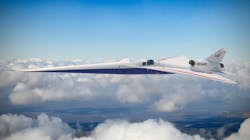NASA Langley works to revive supersonic flight - without sonic booms
WASHINGTON - There was plenty to gape at as NASA Langley Research Center staff briefed members of Virginia’s Capitol Hill delegation — but it was the slender, streamlined X-59 with its promise of supersonic flight without sonic booms that may have best exemplified the work of the nation’s oldest aeronautics lab, Dave Ress reports for The Daily Press. Continue reading original article.
The Military & Aerospace Electronics take:
1 March 2022 - The X-59 is shaped to reduce the loudness of a sonic boom reaching the ground to that of a gentle thump, if it is heard at all. It will be flown above select U.S. communities to generate data from sensors and people on the ground in order to gauge public perception. That data will help regulators establish new rules to enable commercial supersonic air travel over land.
Usually, engines are placed on the bottom of an aircraft, but on the X-59 this section of the inlet and engine are mounted to the top of the plane. This way supersonic shock waves from the inlet and engine are shielded by the wing — one of the many ways that NASA reduces the sonic boom to a sonic thump. With the engine’s unique location on the plane in mind, the team conducts high-speed wind tunnel testing to increase confidence that the inlet will work as designed.
After proving the aircraft works as designed and can fly safely in the national airspace, NASA will fly the X-59 over several participating communities across the country to understand their response to the X-59’s sonic thump. NASA will provide this data to federal and international regulators to enable them to consider setting new guidelines for the possibility of future supersonic commercial travel over land.
Related: Lockheed Martin’s supersonic X-59 could transform everything
Related: NASA marks continued progress on X-59
Related: A view of NASA’s X-59 engine inlet
Jamie Whitney, Associate Editor
Intelligent Aerospace
